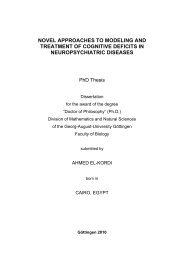Cortical and subcortical mechanisms in persistent stuttering ...
Cortical and subcortical mechanisms in persistent stuttering ...
Cortical and subcortical mechanisms in persistent stuttering ...
Create successful ePaper yourself
Turn your PDF publications into a flip-book with our unique Google optimized e-Paper software.
Chapter 1 Introduction<br />
The respiratory, laryngeal <strong>and</strong> supralaryngeal systems recruit distributed neural networks to<br />
channel the muscle activation <strong>in</strong>to organized spatio-temporal speech movement patterns. The<br />
follow<strong>in</strong>g neural structures are central for this function:<br />
(1) Orofacial <strong>and</strong> laryngeal sensorimotor cortex <strong>and</strong> the corticobulbar <strong>and</strong> the corticosp<strong>in</strong>al<br />
tracts<br />
(2) Premotor cortex, <strong>in</strong>sula, supplementary motor area, <strong>and</strong> c<strong>in</strong>gulate motor area<br />
(3) Motoneurons <strong>in</strong> the bra<strong>in</strong>stem (nucleus trigem<strong>in</strong>us, nucleus facialis, nucleus<br />
glossopharyngeus, nucleus vagus, nucleus accessories, nucleus hypoglossus)<br />
(4) Motoneurons <strong>and</strong> associated sp<strong>in</strong>al <strong>in</strong>terneurons which control the respiratory<br />
musculature are found distributed across cervical segments (C1-C8) <strong>and</strong> thoracic<br />
segments (T1-T12) of the sp<strong>in</strong>al cord<br />
(5) Peripheral nerve fibers of the mentioned motoneurons <strong>and</strong> their neuromuscular junctions<br />
(6) Extrapyramidal tracts, basal ganglia-thalamocortical pathway<br />
(7) Cerebellum with its efferent <strong>and</strong> afferent fibers, cerebello-thalamocortical pathway<br />
Anatomy <strong>and</strong> physiology of speech production is comprehensively described by Steven M.<br />
Barlow or Kenneth N. Stevens (Barlow et al., 1999; Stevens, 2000).<br />
In normal conversation, a speaker produces 3 to 5 <strong>in</strong>telligible syllables per second (Smith,<br />
1992); thus, the nervous system manages to simultaneously control <strong>and</strong> coord<strong>in</strong>ate the<br />
overlapp<strong>in</strong>g articulatory gestures to produce rapidly alter<strong>in</strong>g configurations of the multilevel<br />
execut<strong>in</strong>g speech organs.<br />
Preced<strong>in</strong>g <strong>and</strong> simultaneously, a message that is <strong>in</strong>tended to be transferred to a<br />
communication partner has to be created <strong>and</strong> transformed <strong>in</strong>to the verbal code. This cognitive<br />
process is detailed by Levelt <strong>in</strong> his <strong>in</strong>fluential model of speech production (Levelt, 1989c). A<br />
brief summary of this psychol<strong>in</strong>guistic model which shaped several theories on stutter<strong>in</strong>g is<br />
given <strong>in</strong> Appendix A.<br />
Speech motor control is a further aspect that needs to be considered for the complex process<br />
of speech production. A current model of speech motor control is the Directions <strong>in</strong>to<br />
Velocities of Articulators model (DIVA; Golf<strong>in</strong>opoulos et al., 2010; Guenther, 1994, 1995).<br />
In this model speech motor control is based on a feed forward <strong>and</strong> a feedback control<br />
subsystem. The feedforward process is supposed to control the execution of speech<br />
movements. Additionally, the feedforward subsystem activates predictive <strong>in</strong>ternal models<br />
(efference copies) <strong>in</strong> the feedback subsystem. These <strong>in</strong>ternal models represent the expectation<br />
of the <strong>in</strong>com<strong>in</strong>g somatosensory <strong>and</strong> auditory feedback result<strong>in</strong>g from current speech<br />
11



